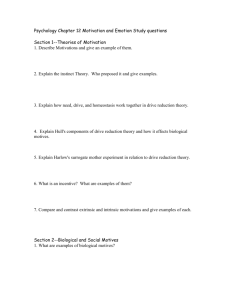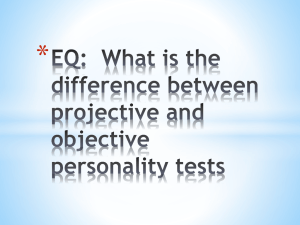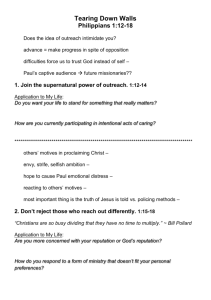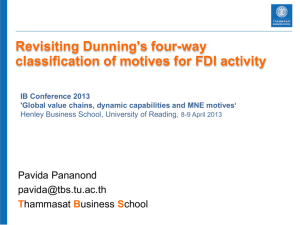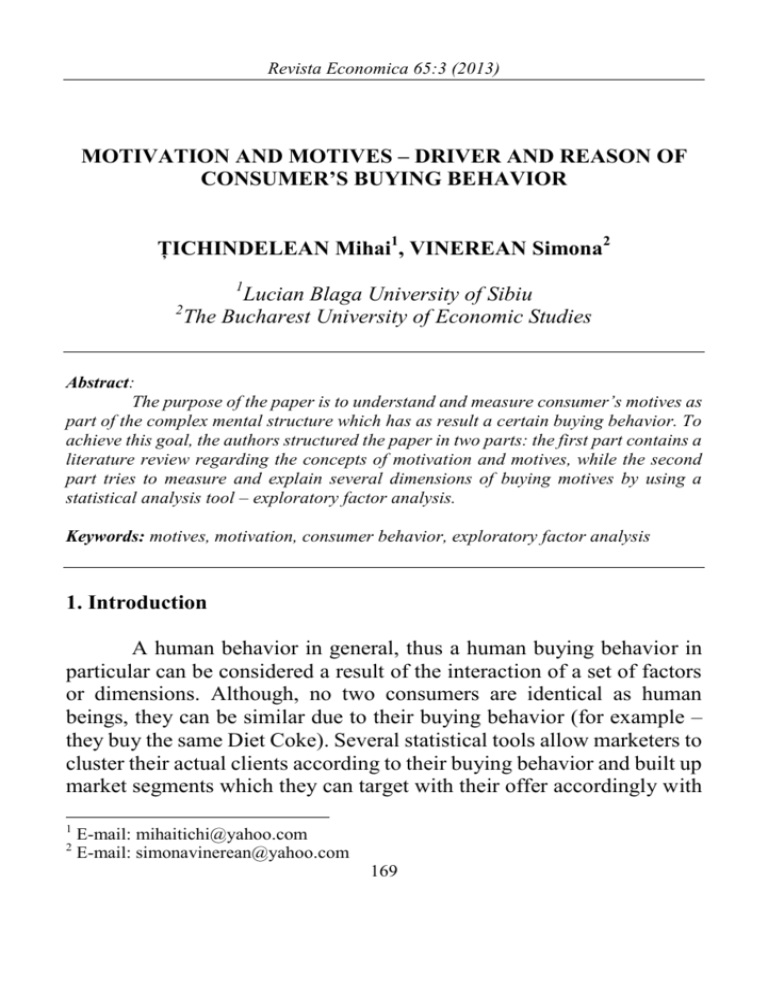
Revista Economica 65:3 (2013)
MOTIVATION AND MOTIVES – DRIVER AND REASON OF
CONSUMER’S BUYING BEHAVIOR
ȚICHINDELEAN Mihai1, VINEREAN Simona2
1
2
Lucian Blaga University of Sibiu
The Bucharest University of Economic Studies
Abstract:
The purpose of the paper is to understand and measure consumer’s motives as
part of the complex mental structure which has as result a certain buying behavior. To
achieve this goal, the authors structured the paper in two parts: the first part contains a
literature review regarding the concepts of motivation and motives, while the second
part tries to measure and explain several dimensions of buying motives by using a
statistical analysis tool – exploratory factor analysis.
Keywords: motives, motivation, consumer behavior, exploratory factor analysis
1. Introduction
A human behavior in general, thus a human buying behavior in
particular can be considered a result of the interaction of a set of factors
or dimensions. Although, no two consumers are identical as human
beings, they can be similar due to their buying behavior (for example –
they buy the same Diet Coke). Several statistical tools allow marketers to
cluster their actual clients according to their buying behavior and built up
market segments which they can target with their offer accordingly with
1
2
E-mail: mihaitichi@yahoo.com
E-mail: simonavinerean@yahoo.com
169
Revista Economica 65:3 (2013)
their resources. A more interesting (and much harder to achieve)
perspective of this market segmentation process is to reverse the
clustering variables – to identify and understand the dimensions or
factors which determine a specific buying behavior and based on these
aspects to predict different buying behaviors. Studied literature, (Catoiu
et al., 1996), groups the factors influencing the consumer buying
behavior into three sets of dimensions:
1. Direct visible influences (demographic and economic factors,
marketing-mix factors and situational factors)
2. Deduced endogenous influences (perception , motivation,
personality, learning and attitude)
3. Deduced exogenous influences (family, membership groups,
reference groups, social class, culture and subculture).
Most of these factors are psychological dimensions which vary in
intensity and appearance from consumer to consumer. Marketers use
different qualitative techniques (for example, focus-group and projective
techniques) to understand several facets of one psychological dimension.
A more appropriate approach to gain better insights of how these
dimensions influence the buying behavior is to consider them in
interaction – as complex structures where the same dimensions interact
in unique forms which result in unique coherent buying behavior.
2. On Motivation and Motives
Motivation is considered the driving force within individuals that
impels them to action (Schiffman and Lazar Kanuk, 2009). This driving
force is the result of a state of tension or restlessness to switch from an
actual and present state to a desired and ideal state. Essentially,
consumers are motivated by a desire to satisfy their needs, namely
perceived lacks, as marketers define them (Blythe, 2007). In a broad
classification (other than the famous Maslow’s hierarchy of needs), these
needs may be utilitarian (regarding the acquirement of objective,
170
Revista Economica 65:3 (2013)
functional, and practical benefits) or may be hedonic or experiential
(concerning the achievement of subjective, pleasurable and emotional
benefits).
Motivation is also identified as “an inner drive that reflects
goal-oriented arousal” (Arnould et al., 2004). Goals are the sought-after
results of motivated behavior. The specific goals that consumers wish to
achieve and the courses of action they take to attain these goals are
selected on the basis of their thinking processes (cognition) and previous
learning (experience) (Schiffman and Lazar Kanuk, 2009). Thus,
marketers should regard motivation as an impetus that incites and
induces consumption, and through these consumption experiences, the
process of consumer learning. Figure 1 presents a model of the
motivational process.
In order to be effective, one must acknowledge the fact that
motivation can be positive or negative. A person may feel a driving force
toward an object and thus may be motivated to do something, or may feel
a driving force away from an object and thus may be motivated to avoid
something. Some psychologists refer to positive drives as needs, wants,
or desires and to negative drives as fears or aversions (Schiffman and
Lazar Kanuk, 2009).
Understanding motivation implies understanding why consumers
behave a certain way. Motives are the reasons people act a certain way.
These motives are present in the buying behavior and the
decision-making process of a product, service, or experience. Arnould et.
al. (2004) presented five types of motives: achievement, power,
uniqueness / novelty, affiliation, and self-esteem motive:
Achievement motive- the drive to experience emotion in
connection with evaluated performance;
1. Power motive - the drive to have control or influence over
another person, group, or the world at large;
2. Uniqueness/novelty motive - the drive to perceive oneself as
different from others;
171
Revista Economica 65:3 (2013)
3. Affiliation motive - the drive to be with people; consumers
sometimes experience a strong motivation to reconnect and
associate with groups;
4. Self-esteem motive - credit for successes, explain away failures,
(consumers) see themselves as better than most others.
Learning
Unfulfilled
Needs, Wants,
and Desires
Tension
Driving
Force
Behavior
Goal or
Need
Fulfilled
Cognitive
Processes
Tension Reduction
Figure 1: Model of Motivational Process
Source: Adapted from Jeffrey F. Dugree et al., “Observations: Translating
Values into Product Wants”, Journal of Advertising Research 36, 6 (November 1996)
Another renowned classification of motives is further presented in
the Table 1.
Table 1: Classification of motives
Motive
Primary motives
Explanation
The reason that leads to the purchase of a product
class.
Secondary motives There are the reasons behind buying a particular
brand.
172
Revista Economica 65:3 (2013)
Rational motives
Based on reasoning, or logical assessment of the
consumer’s situation.
Emotional motives These motives have to do with the consumer’s
feeling about the brand.
Conscious motives Motives of which the consumer is aware.
Dormant motives
Motives operating below the conscious level.
Source: Adapted from Blythe, p.11 (Blythe J., “The essence of Consumer
Behavior”, Prentice Hall Publishing, London, 2007)
Motives are related to goals which can be achieved through action.
A taxonomy of human goals was developed by Ford M.E. and Nicholas
C.W. (1987) and consists of two main human desired consequences:
desired within – person consequences and desired person – environment
consequences. The first group of goals consists of desires which are a
result of the person’s individual structure: affective goals (entertainment,
tranquility, happiness, bodily sensations and physical well-being),
cognitive goals (exploration, understanding, individual creativity and
positive self-evaluation), and subjective organizational goals (unity harmony with people, nature or a greater power, transcendence –
avoiding feeling trapped within the boundaries of ordinal experience).
The second set of goals is based on the relationship person –
environment, namely on how a person perceives the environment he / she
is living in: self-assertive social relationship goals (individuality,
self-determination, superiority, resource acquisition), integrative social
relationship goals (belongingness, social responsibility, equality,
resource provision), and task goals (mastery, task creativity,
management, material gain and safety).
3. Research Methodology
The purpose of this paper is to get a better understanding about
motivation and motives as influence factors of the consumer buying
behavior. Regarding this aspect, the authors try to measure several
173
Revista Economica 65:3 (2013)
buying motives which differ one from another using Blythe’s
classification of motives (Table 1). The survey was used as the research
method and the questionnaire as the data collecting instrument. The
chosen goods and service market is the fuel market of the city of Sibiu,
Romania. As information source, end-customers of fuel stations were
selected as they represent an external information source (clients who are
part of the external environment of the fuel distributing companies), a
primary information source (the obtained data is analyzed for the first
time by the authors) and a free information source. The sample size was
111 respondents, for which the selection variables were two
demographic variables – age above 18 years old and possession of a car –
and a behavioral variable – using the car for at least four times per week.
Moreover, the data collection period was between March 1 and April 8,
2011.
The buying motives were measured by using a Likert scale in form of 20
statements with 5 levels of agreement (Table 2).
Table 2 Likert statements of buying motives
My friends are clients of the same fuel station as I am.
I am attracted by the special offers developed by the fuel station.
The ambient of the fuel station makes me feel uncomfortable.
The TV-adds make me aware of the fuel-station they promote.
The fuel-price is very important in choosing a fuel- station.
The fuel I buy enables a better functioning of my engine.
The home country of the fuel-station matters for me.
In some situations, the distance from the actual location to the preferred
fuel-station restrains me to choose another fuel-station.
Through their friendly attitude, the employees of the fuel-station make
me feel good.
The brand of the fuel-station is a guarantee of the product quality.
I am aware that some fast moving consumer goods can be found only in
some fuel-station shops.
174
Revista Economica 65:3 (2013)
The fuel that I buy enhances the engine power.
The brand awareness of the fuel station has a big influence in choosing a
fuel-station.
The product-diversity of the shop’s offer attracts my attention every time
I visit it.
The auto specialist’s opinion influences me in choosing a fuel station.
Several benefits obtained due to promotional offers, make me choose a
fuel-station in favor of another.
Members of my family use the same fuel-station as I do.
For me, the indoor and outdoor cleanness of the fuel-station is very
important in choosing one fuel-station.
The fuel-price differs significantly from one fuel-station to another.
The employees of the fuel-station solve my problems very quickly, thus
my stay in the fuel-station is very short.
Based on the purpose of this paper - to get more insights related to buying
motives, the authors use a statistical tool, namely exploratory factor
analysis, in order to identify factors (or consistent buying motives
formed out of the 20 statements) which describe in a better way some
triggers of the consumer’ s buying behavior. Therefore, two hypotheses
were developed:
H1: The initial (buying motive) statements are reduced to a number of
factors which contain a significant (70%) part of the initial information.
H2. The created factors differ from one another due to their type and the
similar needs they satisfy, namely how certain characteristics of the
fuel-station are perceived under a single motive.
The data was analyzed by using the statistical software IBM SPSS V.19,
Dimension reduction procedure.
The descriptive statistic box revealed that the respondents have a higher
175
Revista Economica 65:3 (2013)
sense of agreement related to the following statements (buying motives)
(Table 3).
176
Revista Economica 65:3 (2013)
Table 3 Statistics for the Likert statements with a high level of agreement
Statement
Mean Std.
Deviation
4,55
0,49
The fuel that I buy enhances the engine power.
The brand of the fuel-station is a guarantee of the
4,11
product quality.
The brand awareness of the fuel station has a big
4,06
influence in choosing a fuel-station.
For me, the indoor and outdoor cleanness of the
fuel-station is very important in choosing one 4,02
fuel-station.
...
..
In some situations, the distance from the actual
location to the preferred fuel-station restrains me to 2,62
choose another fuel-station.
0,52
0,53
0,66
…
1,13
Very interesting is the fact that statements with a higher degree of
agreement include both rational (fuel enhance engine power,
indoor-outdoor cleanness) and emotional buying motives (brand name
and awareness). In this sense, the idea of client loyalty can be deduced,
thus statements like “distance from the actual location to the preferred
fuel-station restrains me to choose another fuel-station” have a lower
level of agreement.
By screening the correlation matrix of the analyzed variables (the
correlation matrix contains values of Pearson coefficient for every two
analyzed variables), the authors identified no high correlation (over 0.9)
between two variables, and thus the possible problem of multicollinearity
of the data is solved. This fact is reconfirmed by the value of the matrix
determinant (d=0.031) which is higher than the limit value of
determinants (d=0.00001) specific for matrixes with elements
177
Revista Economica 65:3 (2013)
characterized by multicollinearity.
Table 4 Measuring the sample’s adequacy and testing the sphericity
Kaiser-Mayer-Olkin Measure of 0.531
Sample Adequacy
Bartlett’s Test of Sphericity 345.473
Aprox. Chi Square
df 190
Sig. ,000
Table 4 contains information regarding the appropriate use of factor
analysis for the considered data. The limit value of the KMO
Test for which factor analysis is appropriate should be 0.5 (0.531>0.5).
This low value is a result of the small sample size used, because the
diagonal elements of the Anti-Image Matrix (these values are results of
KMO Test for individual variables) have slightly higher values (>0.668).
Bartlett’s test of sphericity tests the hypothesis that the initial correlation
matrix is an identity matrix. For our data set, the significance of the test is
0.00 under the limit of 0.05, thus factor analysis is appropriate.
Factors have been extracted by using the principal component procedure.
This procedure uses by default an initial value of 1 for the communalities
of all initial factors (the number of extracted factors is the same as the
number of variables). Communality represents the common variance of
one variable with the remaining variables. Eigenvalues have been
computed for each of the 20 factors. Based on the Eigenvalues
(according to Kaiser, all factors that have Eigenvalues higher than 1
should be included in the analysis), 8 of the 20 extracted factors were
included in further analysis. These factors explain 72.01% of the total
variance of the data set. This reduction of factors means that the
consumer buying behavior can be explained by a smaller number of
motives (8 factors) with a loss of 28% of the initial information.
178
Revista Economica 65:3 (2013)
The Varimax procedure was used for the orthogonal rotation of the 8
factors. Orthogonal rotation was chosen due to the assumption that
factors should be uncorrelated similar to the buying motives they are
built on.
Table 5 Rotated component matrix
Variables/Factors
1
I am attracted by the special offers developed by the fuel 0.748
station.
Several benefits obtained due to promotional offers, make 0.733
me choose a fuel-station in favor of another.
The product-diversity of the shop’s offer attracts my 0.521
attention every time I visit it.
The TV-adds make me aware of the fuel-station they 0.513
promote.
The brand of the fuel-station is a guarantee of the product
quality.
The brand awareness of the fuel station has a big influence
in choosing a fuel-station.
The home country of the fuel-station matters for me.
The employees of the fuel-station solve my problems very
quickly, thus my stay in the fuel-station is very short.
Through their friendly attitude, the employee of the
fuel-station makes me feel good.
2
3
0.802
0.785
0.507
0.82
7
0.75
8
The rotated component matrix contains the factor loadings (Pearson
correlation coefficient) of the initial variables with the extracted factors.
It is visible that the first factor is built up by statements that measure
different valances of the promotional activity of the fuel-station;
therefore it can be labeled as promotional activity. The second factor has
as components three variables which measure the influence of the brand
perception on the buying behavior. In relation to these aspects, the
second factor is a pure emotional buying motive and can be labeled as
brand perception. A third factor relies on the attitude of the employees
regarding the client of the fuel-station. A pro-active and problem-solving
attitude of the employees can be considered a unique consumer buying
179
Revista Economica 65:3 (2013)
motive (labeled as employee attitude). A forth consistent factor is based
on rational, price-oriented reasoning of the customer, thus labeled as
price sensitivity. The other four factors contain variables or statements
that correlate statistically, but not logical (for example: factor 7 built up
by : Members of my family use the same fuel-station as I do (loading of
0.833) and I am aware that some fast moving consumer goods can be
found only in some fuel-station shops (loading of – 0.428).
4. Conclusion and Future Recommendation
The purpose of the paper is to identify and measure buying motives as
influence factors of the buying behavior. Factor analysis was performed
to reduce the initial data set. The initial data set contained 20 statements
(measured through Likert scales) based on buying motives. The results of
the procedure reduced the initial 20 buying motives to 8 factors (or
motive dimensions) which contain more than 70% of the initial
information. The most important motive dimensions are: promotional
activity, brand perception, employee attitude and price sensitivity. The
results confirm both hypotheses that the initial buying motives can be
reduced to a smaller number of consistent factors (H1) and that the
obtained factor differ one from another based on their classification (H2).
Rational motives (promotional activity and price sensitivity) and
emotional motives (brand perception and employee attitude) form the
reasoning space of the studied consumer.
Further recommendations rely in the use of the identified buying
dimensions on a larger sample size. Future research of the authors will be
oriented towards the result of the interaction of other factors influencing
the consumer buying behavior.
5. References
[1] Catoiu et al., Cercetari de marketing – Marketing Research,
Bucharest, Uranus Publishing, 2007. Vol. 15, No. 6, pp. 432-442, 1996.
[2] Schiffman L. And Lazar Kanuk L., Consumer Behavior – 9th
180
Revista Economica 65:3 (2013)
Edition, New Jersey, Pearson Prentice Hall Publishing, 2009, pp.84-87.
[3] Blythe J., The essence of Consumer Behaviour, London,
Prentice Hall Publishing, 2007, p.11.
[4] Arnould, E., Price, and G. Zinkhan, Consumers, Boston,
McGraw- Hill/Irwin, 2004, p.259.
181



